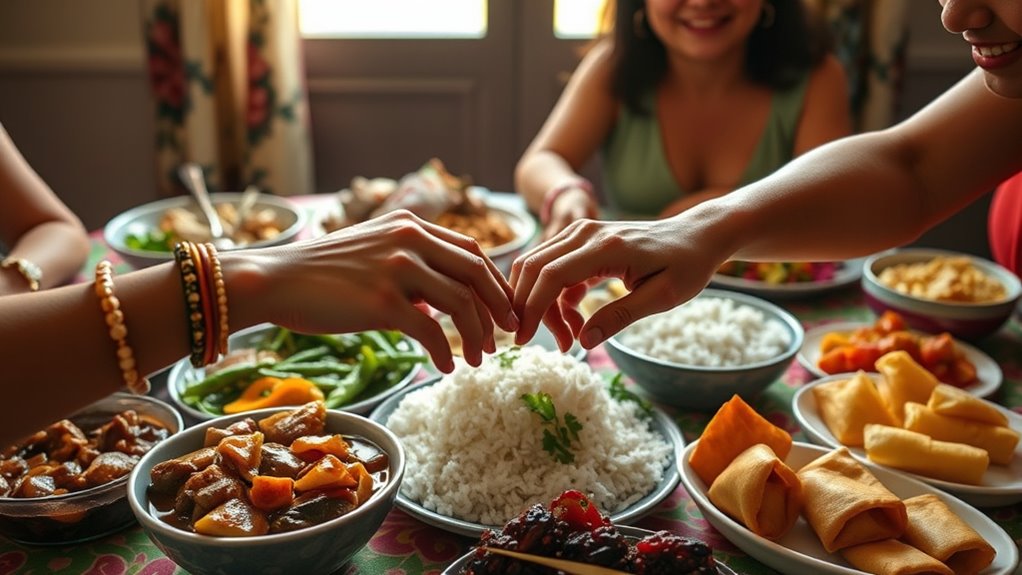Sharing meals is central to Filipino culture and a beautiful way to build love. When you gather around the table, whether for kamayan or a boodle fight, you connect through laughter, flavors, and stories. Each bite of ulam and rice nourishes both body and relationships, creating unforgettable moments together. The warmth and generosity of these meals cultivate a bond that grows deeper. Discover how these shared experiences have the power to transform your own relationships.
Key Takeaways
- Sharing meals during our dates deepened our emotional connection, reflecting the Filipino culture’s emphasis on community and togetherness.
- Preparing traditional Filipino dishes like adobo and lechon allowed us to celebrate our heritage and create lasting memories.
- Embracing kamayan dining brought us closer, as eating with our hands fostered playful interaction and a sense of equality.
- Regular family gatherings reinforced our bond, promoting open communication and strengthening our relationship through shared culinary experiences.
- Our love flourished through the generosity and hospitality we experienced, as each meal became an opportunity to express care and respect for one another.
The Importance of Sharing Meals in Filipino Culture
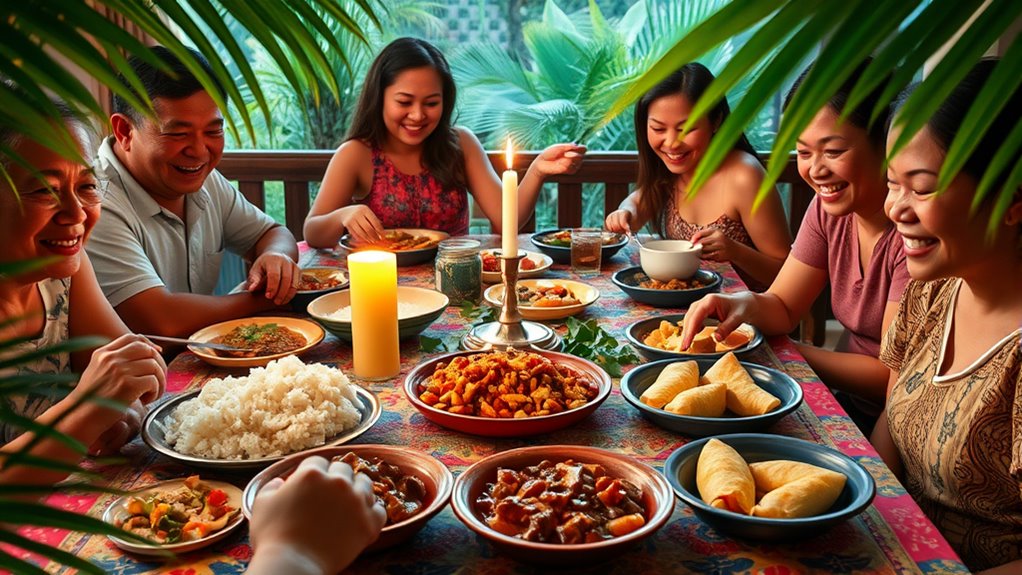
When you sit down to share a meal in Filipino culture, you’re not just enjoying food; you’re participating in a rich tradition that emphasizes social bonding and community. Meals bring people together, strengthening relationships and creating a sense of belonging.
Each dish tells a story, reflecting cultural heritage and diverse influences, from Malay to Spanish. When you share food, it symbolizes generosity and hospitality, welcoming friends and strangers alike into your home.
Community events, like fiestas, revolve around shared meals, enhancing joy and unity. This act of sharing isn’t just about nourishment; it’s a blessing that fosters emotional support and deepens connections, preserving cultural identity and traditions for future generations.
Embracing Kamayan: A Unique Dining Experience

Sharing meals in Filipino culture naturally leads to the unique experience of Kamayan, where food becomes a tactile celebration.
You’ll find yourself gathered around a communal table, surrounded by family and friends, digging into a vibrant spread laid out on banana leaves. Eating with your hands connects you to the food and each other, enhancing the communal spirit.
As you pick up flavorsome dishes like lechon and adobo, you engage in a lively atmosphere filled with laughter and stories. This hands-on approach not only revives traditional practices but also strengthens family bonds during special occasions.
Each bite is a celebration of heritage, making Kamayan a memorable dining experience that resonates beyond the meal itself.
The Role of Ulam and Rice in Our Culinary Bond
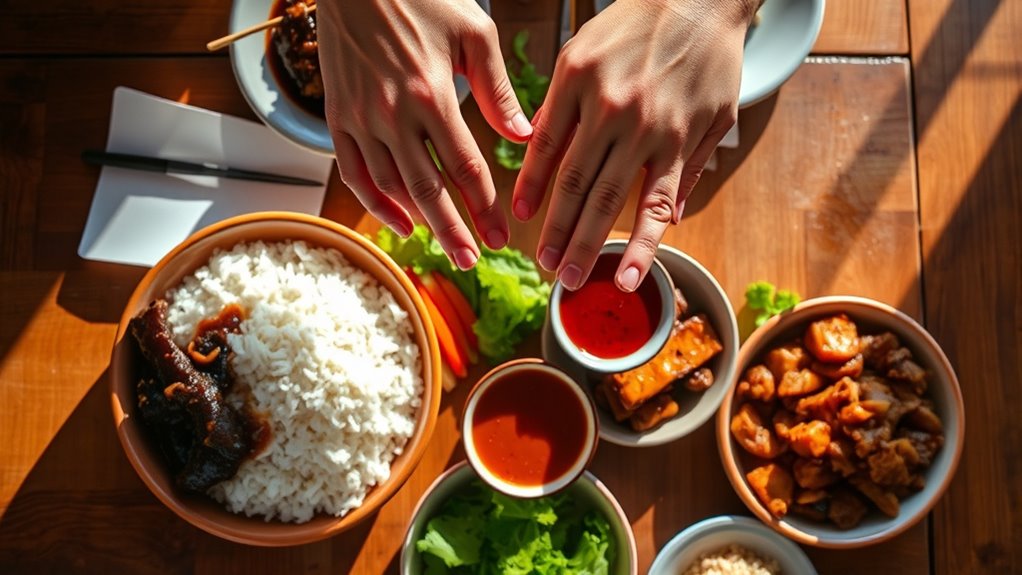
Ulam and rice form the heart of Filipino meals, embodying a rich tapestry of culture and tradition. You’ll find that ulam, whether it’s adobo, sinigang, or kare-kare, showcases the diversity of Filipino flavors. Each dish is often a family recipe, handed down through generations, connecting you to your roots.
Rice, the staple of every meal, complements ulam perfectly, creating a satisfying experience. As you gather around the table, the act of sharing these dishes fosters camaraderie and strengthens bonds.
The communal dining experience, where everyone digs in together, emphasizes the importance of family and friendship. Ultimately, ulam and rice not only nourish your body but also nourish the relationships that matter most.
Celebrating Togetherness Through Boodle Fights
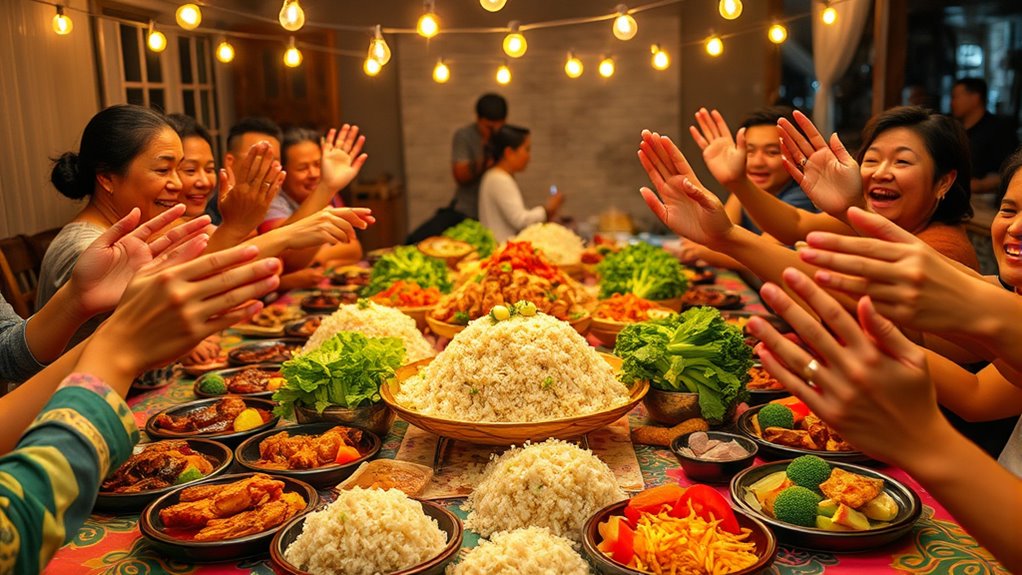
Gathering around a table filled with delicious food isn’t just about the meal; it’s about the bonds formed over shared experiences.
Sharing a meal goes beyond food; it nurtures connections and creates lasting memories through shared experiences.
Boodle fights, with their roots in military tradition, symbolize equality and camaraderie as everyone digs in together, hands-on. This communal style celebrates unity, inviting people of all backgrounds to share the same feast on banana leaves.
You’ll find a variety of grilled meats, seafood, and rice, encouraging lively interaction and laughter among participants.
Whether it’s a casual gathering or a grand celebration, boodle fights create unforgettable moments that strengthen community ties.
Food as a Medium for Storytelling and Connection

Food serves as a vibrant medium for storytelling and connection, weaving together the threads of culture, history, and community. Each dish, like Adobo or Lechon, reflects the rich tapestry of Filipino heritage, showcasing indigenous, Spanish, and Chinese influences. These meals aren’t just about taste; they evoke memories of ancestors and historical events, preserving cultural identity amid changing times. Regional specialties, such as Bicol Express and Inasal, highlight local traditions and flavors, sharing unique narratives that enrich the Filipino experience. When you gather around a table for a shared meal, you’re not just enjoying food; you’re participating in a deep-rooted tradition that fosters unity and connection, bridging gaps between generations and cultures. Just as Cacciucco represents the coastal culinary heritage of Italy, each dish tells a story of its origins and the people who cherish it. Similarly, Indian meals like Idli Sambar embody a rich cultural history, illustrating the significance of food in connecting diverse communities. Moreover, unique culinary experiences that focus on regional flavors create memorable tasting adventures that resonate deeply with food lovers. Additionally, the concept of halal living emphasizes the importance of dietary choices in fostering community and cultural identity. Fermented vegetables can also enhance these meals, providing not only diverse flavors but also additional nutritional benefits that reflect the growing trend of health-conscious eating.
Generosity and Hospitality: Key Filipino Values
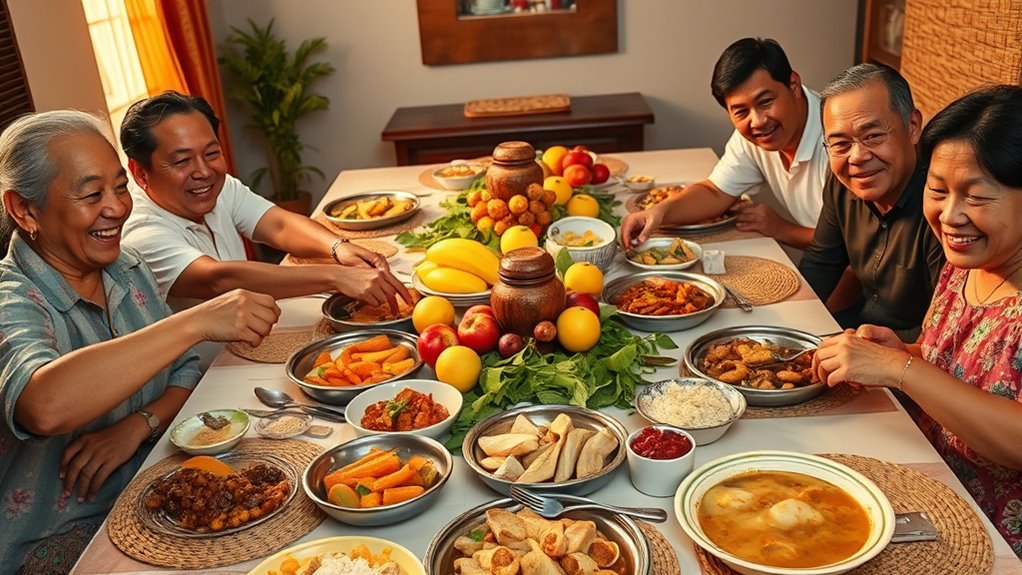
When you share a meal in the Philippines, you’re not just enjoying flavors; you’re experiencing a culture steeped in generosity and hospitality.
Filipinos take pride in offering their best dishes, ensuring that every guest feels welcomed, even if resources are limited. This spirit of generosity is woven into the fabric of family and community life, reflecting deep respect for others, especially elders.
In every Filipino home, the spirit of generosity shines through, welcoming guests with the best dishes regardless of resources.
You’ll find that homes are warm and inviting, often asking guests to remove their shoes as a sign of respect. Values like pakikisama, or getting along, and bayanihan, the spirit of communal unity, further enhance this culture. Additionally, this communal spirit fosters a sense of belonging, making every meal an opportunity to strengthen relationships.
Each meal becomes a celebration of connection, where every bite carries the essence of Filipino warmth and inclusivity.
The Emotional Impact of Shared Dining Experiences

Sharing a meal can create an emotional bond that transcends mere nourishment, fostering connections and enhancing relationships among participants. When you dine with others, you’re not just enjoying food; you’re building trust and communication.
These shared experiences can greatly reduce feelings of loneliness and depression, promoting mental health. As you engage in meaningful dialogue over a meal, social bonds strengthen, leading to increased happiness and lower stress levels.
Regularly sharing meals contributes to a sense of belonging, making you feel more connected to your loved ones. The joy of eating together elevates your mood, creating a positive atmosphere that enhances your appreciation for life. Additionally, live music at dining venues can further enrich these shared experiences, making them even more memorable.
Ultimately, shared dining enriches your emotional well-being and cultivates lasting relationships.
Transforming Leftovers: Creativity and Resourcefulness
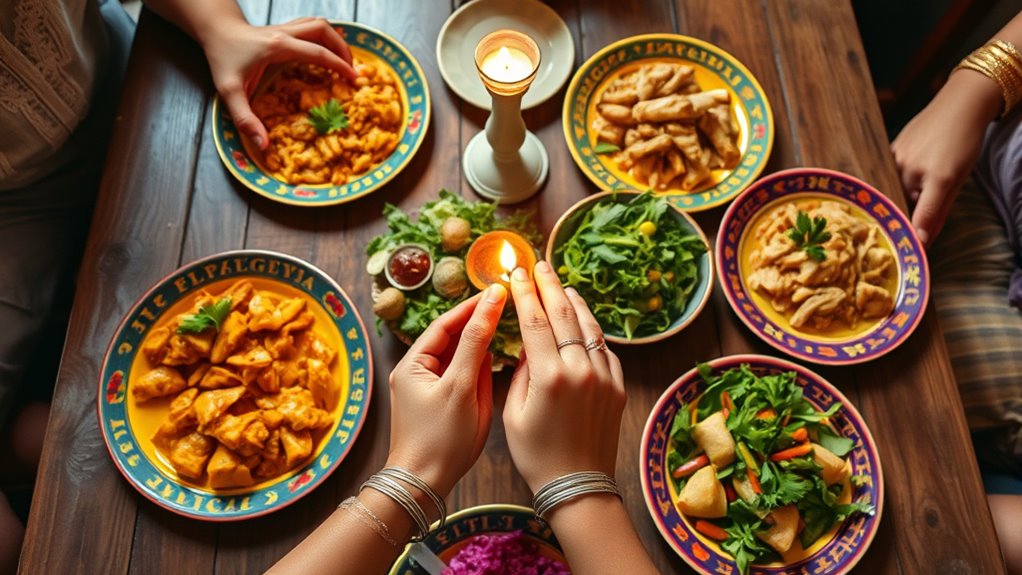
Building connections over shared meals often leads to a wealth of delicious leftovers, inviting creativity and resourcefulness in the kitchen.
You can transform those remnants into mouthwatering dishes like hearty soups, where leftover bones and veggies simmer into a comforting bowl. Imagine whipping up risottos, blending leftover chicken or vegetables into creamy goodness. Additionally, apiculturists often create unique recipes using honey, adding a delightful sweetness to various dishes. Using herbal infusion machines can also help elevate the flavors of your leftovers, allowing you to create rich, infused oils or butters that enhance your meals. Moreover, incorporating organic juices into your recipes can provide a fresh burst of flavor and nutrients.
Layer various leftovers into a convenient casserole or fill pastry shells to create pot pies. Stir-fries allow you to toss in any leftover veggies with spices for a quick meal.
For a global twist, turn leftover rice into fried rice or stuff tacos with leftover meats. With a bit of imagination, your leftovers become culinary treasures that honor both tradition and sustainability. Additionally, incorporating more raw foods into your meals can enhance nutrient retention and promote overall health.
Strengthening Relationships Through Shared Meals

While family meals may seem like a simple routine, they play an essential role in strengthening relationships among loved ones. Sharing meals enhances communication, allowing you to express feelings and concerns openly. These moments create traditions, like saying grace, fostering unity and stability. Regular family gatherings can also promote emotional and psychological growth, as they provide a safe space for family members to share their thoughts and feelings. Furthermore, enjoying Italian cuisine together can introduce new flavors and create memorable experiences that bring families closer. Including a variety of colors on the plate can also enhance the nutritional value of family meals, contributing to better health for all members. For instance, dishes like Akara from Nigeria and Ghana offer a protein-rich option that can be enjoyed during family meals.
As you gather around the table, you build a sense of belonging and identity through shared memories and cultural practices. Frequent family meals are also linked to better emotional well-being, reducing feelings of isolation. They encourage collaborative problem-solving and support, helping each other navigate challenges. Plus, regular dinners boost academic performance in children, promoting commitment to schoolwork. Ultimately, these shared experiences weave a stronger fabric of love and connection in your family. Additionally, cross-cultural romance often thrives on shared experiences like meals, further deepening bonds between partners.
Frequently Asked Questions
What Are Common Filipino Dishes Served During Shared Meals?
When you think of common Filipino dishes served during shared meals, several mouthwatering options come to mind.
You might enjoy flavorful Adobo Fried Rice or the comforting Arroz Caldo. Pancit Canton offers a delightful noodle experience, while Lechon often steals the show at celebrations.
Don’t forget about Lumpia for a crunchy appetizer, and for dessert, Halo-Halo makes a revitalizing finish.
These dishes create a vibrant and communal dining experience that Filipino culture embraces.
How Can I Host a Boodle Fight at Home?
To host a boodle fight at home, start by choosing a theme that reflects Filipino culture.
Set up long tables covered with banana leaves and prepare a variety of dishes like grilled meats, adobo, and fresh fruits.
Invite guests to participate by explaining the rules of eating with their hands.
Create a lively atmosphere with music and conversation.
Finally, make sure you have enough supplies and a cleanup plan for after the feast.
Enjoy!
What Is the Significance of Using Banana Leaves in Dining?
Did you know that over 70% of households in Southern India still use banana leaves for dining?
Using banana leaves in dining isn’t just about tradition; it’s a sustainable choice that enhances flavor and promotes hygiene. The natural wax on the leaves adds an earthy taste, while their biodegradable nature reduces waste.
Plus, they’re easy to clean and portable, making them perfect for gatherings. Embracing this practice connects you with culture and community.
How Do I Politely Decline Food Offerings in Filipino Culture?
To politely decline food offerings in Filipino culture, express your gratitude first. Say “thank you” or “salamat,” then mention you’re full.
Wait until all dishes are served before deciding. If they insist, you can smile and repeat your refusal gently.
If needed, excuse yourself for a moment to shift attention. Emphasizing dietary restrictions can also help.
Always show appreciation for your host’s effort to maintain respect and kindness in your communication.
What Are Traditional Filipino Beverages Served During Meals?
When you think of traditional Filipino meals, you can’t ignore the beverages that accompany them.
From the invigorating calamansi juice to the sweet sip of sago’t gulaman, each drink enhances the dining experience. You might also enjoy iced salabat, contrasting the warm comfort of meals, or indulge in the unique flavors of guinumis.
Whether it’s a feast or a simple gathering, these beverages foster connection, making every meal memorable and vibrant.
Conclusion
As you gather around the table, surrounded by the vibrant colors of ulam and steaming rice, you can feel the warmth of connection enveloping you. Each shared bite tells a story, weaving memories into the fabric of your relationships. The laughter mingles with the aroma of spices, creating an atmosphere that feels like home. In these moments, you realize that love, much like a well-prepared meal, is best when shared, nourishing both the body and the soul.
